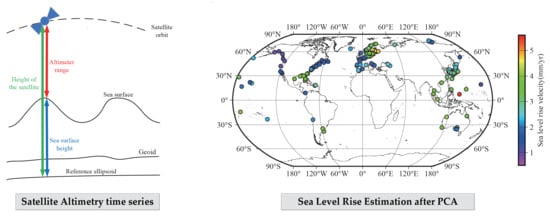Enhancing Sea Level Rise Estimation and Uncertainty Assessment from Satellite Altimetry through Spatiotemporal Noise Modeling
Abstract
:1. Introduction
2. Data, Processing Software, and Methodology
2.1. Satellite Altimetry and Sea Surface Height
2.2. Sea Surface Height Observations from Copernicus
2.3. Geophysical Fluid-Loading Product
2.4. Stochastic Noise Property of Sea Surface Height Time Series
2.5. Common Mode Noise Reduction with Principal Component Analysis
2.6. Toolbox for Sea Surface Hight Processing and Analysis
3. Results
3.1. Stochastic Noise Property Analysis of SSH Time Series
3.2. Geophysical Fluid-Loading Effect of SSH Time Series
3.3. Trend Analysis on SSH Time Series with PCA
4. Discussion: SLR Change Estimated from SA
5. Conclusions
Author Contributions
Funding
Data Availability Statement
Acknowledgments
Conflicts of Interest
Appendix A
| Value (mm/yr) | Site | ARFIMA (1, d, 1) | ARMA (1, 1) | GGM | FNWN | PLWN | RWFNWN |
|---|---|---|---|---|---|---|---|
| Velocity | 0485 | 2.33 | 2.15 | 2.15 | 2.65 | 0.34 | 2.93 |
| 0636 | 1.74 | 1.75 | 1.75 | 1.46 | 1.10 | 1.46 | |
| 0413 | 2.18 | 2.16 | 2.16 | 2.42 | 2.40 | 2.42 | |
| 0819 | 3.43 | 3.37 | 3.37 | 2.75 | 2.86 | 2.75 | |
| 0202 | 1.51 | 1.46 | 1.45 | 1.43 | 1.46 | 1.43 | |
| 1299 | 1.63 | 1.81 | 1.79 | 1.38 | 1.47 | 1.38 | |
| Uncertainty | 0485 | 0.41 | 0.17 | 0.16 | 1.09 | 314.41 | 55.45 |
| 0636 | 0.70 | 0.31 | 0.36 | 6.21 | 21.21 | 6.21 | |
| 0413 | 0.40 | 0.35 | 0.37 | 5.30 | 2.85 | 5.30 | |
| 0819 | 0.21 | 0.29 | 0.30 | 8.03 | 3.11 | 8.03 | |
| 0202 | 0.52 | 0.18 | 0.23 | 2.40 | 1.86 | 2.40 | |
| 1299 | 0.64 | 0.17 | 0.25 | 2.00 | 1.38 | 2.00 | |
| Mean Uncertainty | 0.48 ± 0.16 | 0.25 ± 0.07 | 0.28 ± 0.07 | 4.17 ± 2.51 | 57.47 ± 115.12 | 13.23 ± 19.00 | |
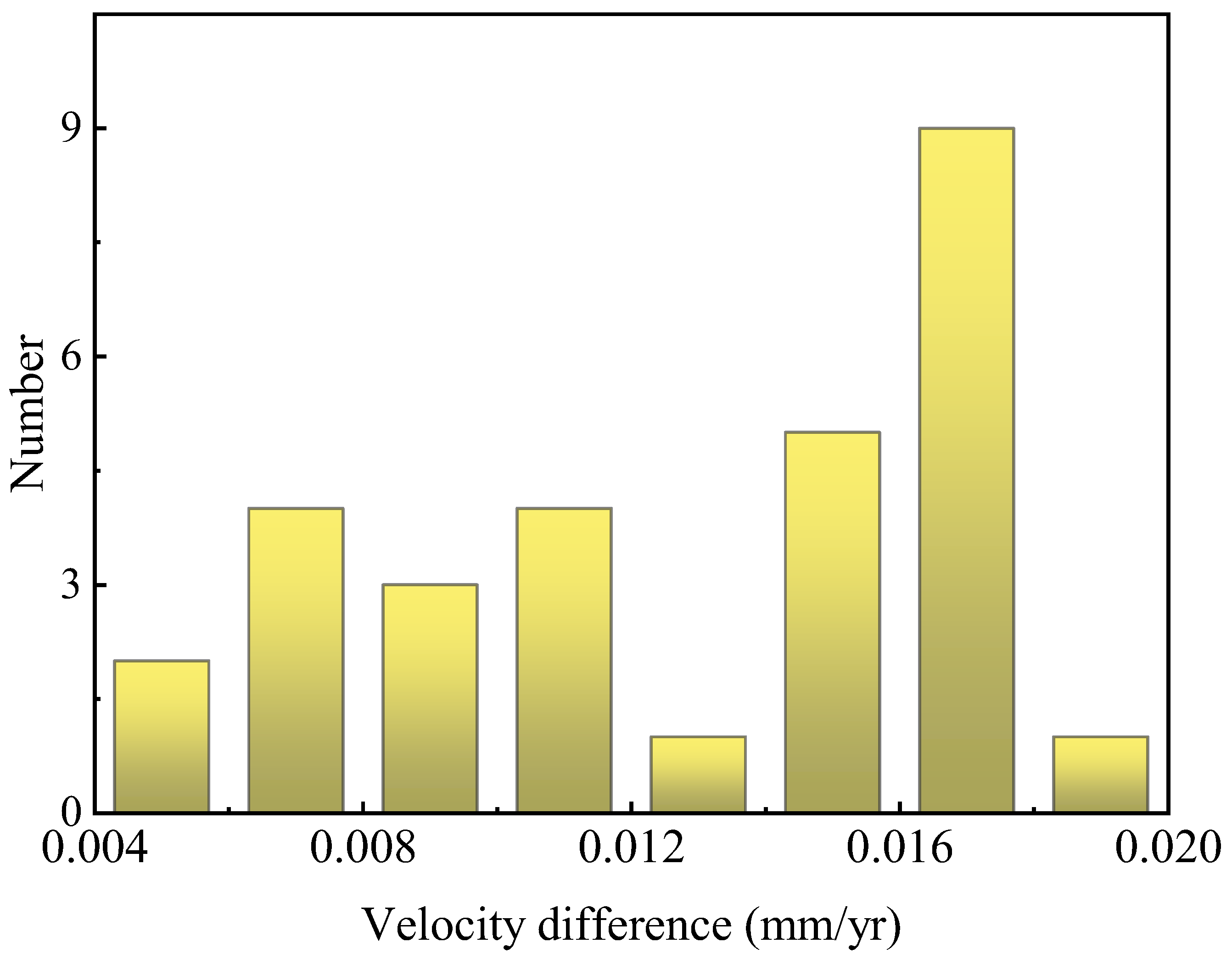
| Uncertainty Ratio | ||
|---|---|---|
| Max | 2.07 | 1.27 |
| Min | 0.82 | 0.92 |
| Mean | 0.93 | 1.16 |

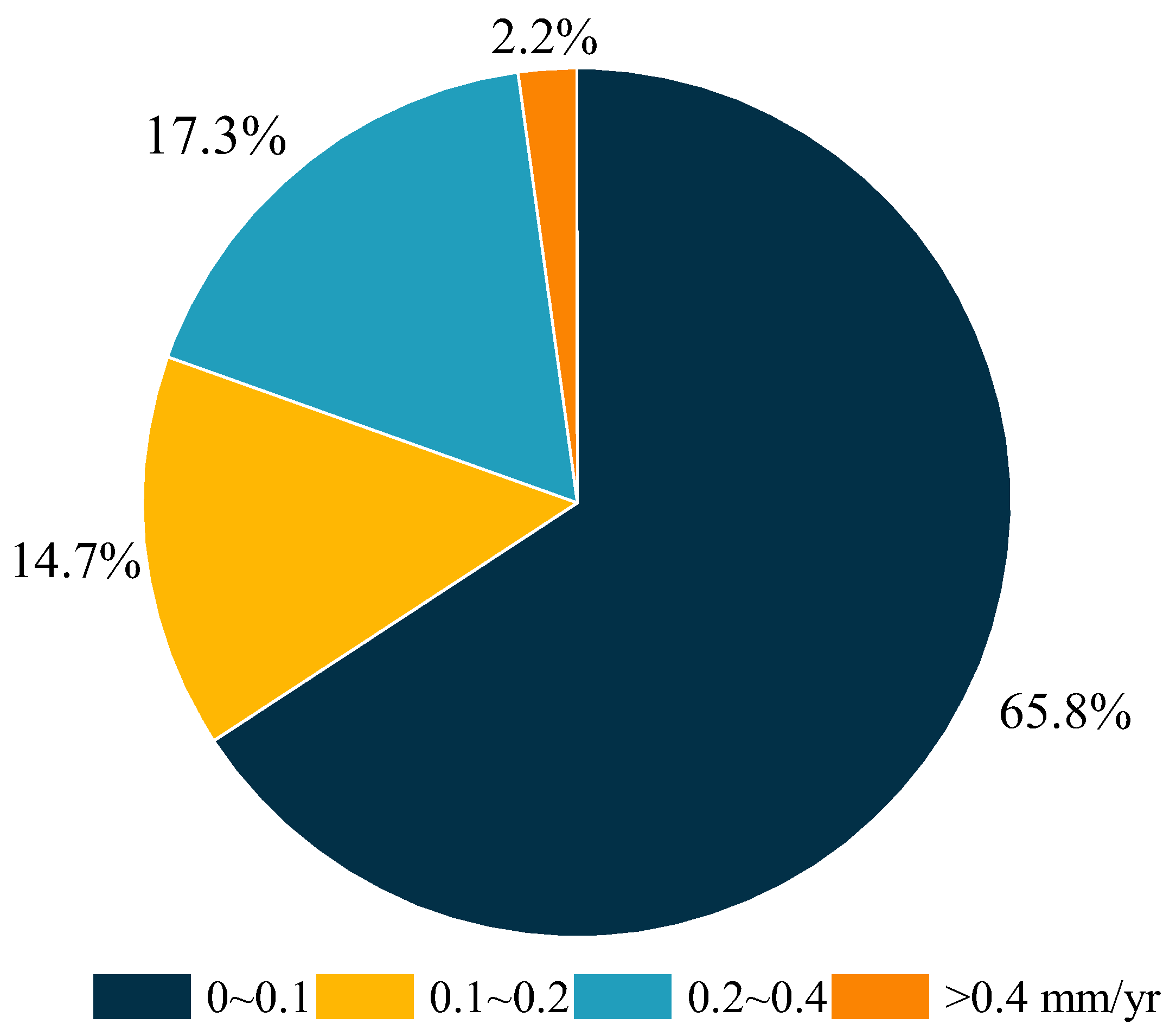
| PCs | SSH |
|---|---|
| Contribution Rate (%) | |
| 1 | 28.0 |
| 2 | 15.1 |
| 3 | 8.7 |
| 4 | 7.9 |
| 5 | 6.7 |
| 6 | 3.9 |
| 7 | 2.7 |
| 8 | 2.2 |
| 9 | 2.1 |
| 10 | 2.0 |
| 11 | 1.9 |
| Values | Period | Mean |
|---|---|---|
| Velocity (mm/yr) | 1993–2006 | 2.46 ± 1.83 |
| 2000–2013 | 3.02 + 1.41 | |
| 2007–2020 | 3.02 ± 2.10 | |
| 1993–2020 | 2.75 ± 0.89 |
Appendix B
| Area | Number | Velocity |
|---|---|---|
| 1 | 16 | 1.61 ± 0.67 |
| 2 | 34 | 2.49 ± 0.81 |
| 3 | 67 | 2.92 ± 0.91 |
| 4 | 55 | 3.00 ± 0.65 |
| 5 | 12 | 2.96 ± 0.79 |
References
- Church, J.A.; White, N.J. Sea-level rise from the late 19th to the early 21st century. Surv. Geophys. 2011, 32, 585–602. [Google Scholar] [CrossRef]
- Nerem, R.S.; Beckley, B.D.; Fasullo, J.T.; Hamlington, B.D.; Masters, D.; Mitchum, G.T. Climate-change–driven accelerated sea-level rise detected in the altimeter era. Proc. Natl. Acad. Sci. USA 2018, 115, 2022–2025. [Google Scholar] [CrossRef]
- Van de Wal, R.S.W.; Zhang, X.; Minobe, S.; Jevrejeva, S.; Riva, R.E.M.; Little, C.; Richter, K.; Palmer, M.D. Uncertainties in long-term twenty-first century process-based coastal sea-level projections. Surv. Geophys. 2019, 40, 1655–1671. [Google Scholar] [CrossRef]
- Frederikse, T.; Landerer, F.W.; Caron, L.; Adhikari, S.; Parkes, D.; Humphrey, V.; Dangendorf, S.; Hogarth, P.; Zanna, L.; Cheng, L.; et al. The causes of sea-level rise since 1900. Nature 2020, 584, 393–397. [Google Scholar] [CrossRef]
- Dangendorf, S.; Hay, C.; Calafat, F.M.; Marcos, M.; Piecuch, C.G.; Berk, K.; Jensen, J. Persistent acceleration in global sea-level rise since the 1960s. Nat. Clim. Chang. 2019, 9, 705–710. [Google Scholar] [CrossRef]
- Edwards, T.L.; Nowicki, S.; Marzeion, B.; Hock, R.; Goelzer, H.; Seroussi, H.; Jourdain, N.C.; Slater, D.A.; Turner, F.E.; Smith, C.J.; et al. Projected land ice contributions to twenty-first-century sea level rise. Nature 2021, 593, 74–82. [Google Scholar] [CrossRef]
- Zhao, Q.; Pan, J.; Devlin, A.T.; Tang, M.; Yao, C.; Zamparelli, V.; Falabella, F.; Pepe, A. On the Exploitation of Remote Sensing Technologies for the Monitoring of Coastal and River Delta Regions. Remote Sens. 2022, 14, 2384. [Google Scholar] [CrossRef]
- Burgette, R.J.; Watson, C.S.; Church, J.A.; White, N.J.; Tregoning, P.; Coleman, R. Characterizing and minimizing the effects of noise in tide gauge time series: Relative and geocentric sea level rise around Australia. Geophys. J. Int. 2013, 194, 719–736. [Google Scholar] [CrossRef]
- Bos, M.S.; Williams, S.D.P.; Araújo, I.B.; Bastos, L. The effect of temporal correlated noise on the sea level rate and acceleration uncertainty. Geophys. J. Int. 2014, 196, 1423–1430. [Google Scholar] [CrossRef]
- Royston, S.; Watson, C.S.; Legrésy, B.; King, M.A.; Church, J.A.; Bos, M.S. Sea-level trend uncertainty with Pacific climatic variability and temporally-correlated noise. J. Geophys. Res.-Oceans 2018, 123, 1978–1993. [Google Scholar] [CrossRef]
- Woodworth, P.L.; Tsimplis, M.N.; Flather, R.A.; Shennan, I. A review of the trends observed in British Isles mean sea level data measured by tide gauges. Geophys. J. Int. 1999, 136, 651–670. [Google Scholar] [CrossRef]
- Bos, M.S.; Fernandes, R.M.S.; Williams, S.D.P.; Bastos, L. Fast error analysis of continuous GNSS observations with missing data. J. Geodesy 2013, 87, 351–360. [Google Scholar] [CrossRef]
- He, X.; Montillet, J.-P.; Fernandes, R.; Melbourne, T.I.; Jiang, W.; Huang, Z. Sea Level Rise Estimation on the Pacific Coast from Southern California to Vancouver Island. Remote Sens. 2022, 14, 4339. [Google Scholar] [CrossRef]
- He, X.; Hua, X.; Yu, K.; Xuan, W.; Lu, T.; Zhang, W.; Chen, X. Accuracy enhancement of GPS time series using principal component analysis and block spatial filtering. Adv. Space Res. 2015, 55, 1316–1327. [Google Scholar] [CrossRef]
- He, X.; Yu, K.; Montillet, J.-P.; Xiong, C.; Lu, T.; Zhou, S.; Ma, X.; Cui, H.; Ming, F. GNSS-TS-NRS: An Open-source MATLAB-Based GNSS time series noise reduction software. Remote Sens. 2020, 12, 3532. [Google Scholar] [CrossRef]
- Burnham, K.P.; Anderson, D.R. Model Selection and Multimode Inference: A Practical Information-Theoretic Approach, 2nd ed.; Springer: New York, NY, USA, 2002. [Google Scholar]
- Jones, I.F.; Levy, S. Signal-to-noise ratio enhancement in multichannel seismic data via the Karhunen-Loeve transform. Geophys. Prospect. 1987, 35, 12–32. [Google Scholar] [CrossRef]
- Paterson, C. Practical Signal Processing and Its Applications; Springer: Berlin/Heidelberg, Germany, 2021; ISBN -13: 978-3030747281. [Google Scholar]
- Cazenave, A.; Gouzenes, Y.; Birol, F.; Leger, F.; Passaro, M.; Calafat, F.M.; Shaw, A.; Nino, F.; Legeais, J.F.; Oelsmann, J.; et al. Sea level along the world’s coastlines can be measured by a network of virtual altimetry stations. Commun. Earth Environ. 2022, 3, 117. [Google Scholar] [CrossRef]
- Chelton, D.B.; Schlax, M.G. The accuracies of smoothed sea surface height fields constructed from tandem satellite altimeter datasets. J. Atmos. Ocean. Technol. 2003, 20, 1276–1302. [Google Scholar] [CrossRef]
- Jiang, W.; Li, Z.; van Dam, T.; Ding, W. Comparative analysis of different environmental loading methods and their impacts on the GPS height time series. J. Geodesy 2013, 87, 687–703. [Google Scholar] [CrossRef]
- Dill, R.; Dobslaw, H. Numerical simulations of global-scale high-resolution hydrological crustal deformations. J. Geophys. Res. Solid Earth 2013, 118, 5008–5017. [Google Scholar] [CrossRef]
- Langbein, J.; Johnson, H. Correlated errors in geodetic time series: Implications for time-dependent deformation. J. Geophys. Res. Solid Earth 1997, 102, 591–603. [Google Scholar] [CrossRef]
- Mao, A.; Harrison, C.G.; Dixon, T.H. Noise in GPS coordinate time series. J. Geophys. Res. Solid Earth 1999, 104, 2797–2816. [Google Scholar] [CrossRef]
- Baig, A.M.; Campillo, M.; Brenguier, F. Denoising seismic noise cross correlations. J. Geophys. Res. Solid Earth 2009, 114. [Google Scholar] [CrossRef]
- He, X.; Montillet, J.-P.; Fernandes, R.; Bos, M.; Yu, K.; Hua, X.; Jiang, W. Review of current GPS methodologies for producing accurate time series and their error sources. J. Geodyn. 2017, 106, 12–29. [Google Scholar] [CrossRef]
- Nerem, R.S.; Chambers, D.P.; Choe, C.; Mitchum, G.T. Estimating mean sea level change from the TOPEX and Jason altimeter missions. Mar. Geod. 2010, 33, 435–446. [Google Scholar] [CrossRef]
- Bennett, R.A. Instantaneous deformation from continuous GPS: Contributions from quasi-periodic loads. Geophys. J. Int. 2008, 174, 1052–1064. [Google Scholar] [CrossRef]
- Klos, A.; Bos, M.S.; Bogusz, J. Detecting time-varying seasonal signal in GPS position time series with different noise levels. GPS Solut. 2018, 22, 21. [Google Scholar] [CrossRef]
- Montillet, J.P.; Melbourne, T.I.; Szeliga, W.M. GPS vertical land motion corrections to sea-level rise estimates in the Pacific Northwest. J. Geophys. Res.-Oceans 2018, 123, 1196–1212. [Google Scholar] [CrossRef]
- Wöppelmann, G.; Marcos, M. Coastal sea level rise in southern Europe and the nonclimate contribution of vertical land motion. J. Geophys. Res.-Oceans 2012, 117. [Google Scholar] [CrossRef]
- He, X.; Bos, M.S.; Montillet, J.P.; Fernandes, R.M.S. Investigation of the noise properties at low frequencies in long GNSS time series. J. Geodesy 2019, 93, 1271–1282. [Google Scholar] [CrossRef]
- Wdowinski, S.; Bock, Y.; Zhang, J.; Fang, P.; Genrich, J. Southern California permanent GPS geodetic array: Spatial filtering of daily positions for estimating coseismic and postseismic displacements induced by the 1992 Landers earthquake. J. Geophys. Res. Solid Earth. 1997, 102, 18057–18070. [Google Scholar] [CrossRef]
- Dong, D.; Fang, P.; Bock, Y.; Webb, F.; Prawirodirdjo, L.; Kedar, S.; Jamason, P. Spatiotemporal filtering using principal component analysis and Karhunen-Loeve expansion approaches for regional GPS network analysis. J. Geophys. Res. Solid Earth 2006, 111. [Google Scholar] [CrossRef]
- He, X.; Bos, M.S.; Montillet, J.-P.; Fernandes, R.; Melbourne, T.; Jiang, W.; Li, W. Spatial variations of stochastic noise properties in GPS time series. Remote Sens. 2021, 13, 4534. [Google Scholar] [CrossRef]
- Hu, Z.; Li, H.; Wang, D. Characterizing Tidal Currents and Guangdong Coastal Current Over the Northern South China Sea Shelf Using Himawari-8 Geostationary Satellite Observations. Earth Space Sci. 2023, 10, e2023EA003047. [Google Scholar] [CrossRef]
- Aubrey, D.G.; Emery, K.O. Australia: An unstable platform for tide-gauge measurements of changing sea levels. J. Geodesy 1986, 94, 699–712. [Google Scholar] [CrossRef]
- Farzaneh, S.; Parvazi, K. ATSAT: A MATLAB-based software for multi-satellite altimetry data analysis. Earth Sci. Inform. 2021, 14, 1665–1678. [Google Scholar] [CrossRef]
- Langbein, J. Improved efficiency of maximum likelihood analysis of time series with temporally correlated errors. J. Geodesy 2017, 91, 985–994. [Google Scholar] [CrossRef]
- Klos, A.; Dobslaw, H.; Dill, R.; Bogusz, J. Identifying the sensitivity of GPS to non-tidal loadings at various time resolutions: Examining vertical displacements from continental Eurasia. GPS Solut. 2021, 25, 89. [Google Scholar] [CrossRef]
- Schneider, T. Analysis of incomplete climate data: Estimation of mean values and covariance matrices and imputation of missing values. J. Climate 2001, 14, 853–871. [Google Scholar] [CrossRef]
- Hartmann, D.L.; Tank, A.M.G.K.; Rusticucci, M.J.I.A. IPCC fifth assessment report, climate change 2013: The physical science basis. Ipcc Ar5 2013, 5, 31–39. [Google Scholar]
- Intergovernmental Panel on Climate Change. IPCC Special Report on the Ocean and Cryosphere in a Changing Climate; Pörtner, H.-O., Roberts, D.C., Eds.; IPCC: Geneva, Switzerland, 2019. [Google Scholar]
- Cazenave, A.; Palanisamy, H.; Ablain, M. Contemporary sea level changes from satellite altimetry: What have we learned? What are the new challenges? Adv. Space Res. 2018, 62, 1639–1653. [Google Scholar] [CrossRef]
- Horwath, M.; Gutknecht, B.D.; Cazenave, A.; Palanisamy, H.K.; Marti, F.; Marzeion, B.; Paul, F.; Le Bris, R.; Hogg, A.E.; Otosaka, I.; et al. Global sea-level budget and ocean-mass budget, with focus on advanced data products and uncertainty characterisation. Earth Syst. Sci. Data Discuss. 2021, 2021, 1–51. [Google Scholar] [CrossRef]
- Camargo, C.M.L.; Riva, R.E.M.; Hermans, T.H.J.; Schütt, E.M.; Marcos, M.; Hernandez-Carrasco, L.; Slangen, A.B.A. Regionalizing the sea-level budget with machine learning techniques. Ocean Sci. 2023, 19, 17–41. [Google Scholar] [CrossRef]
- Taqi, A.M.; Al-Subhi, A.M.; Alsaafani, M.A.; Abdulla, C.P. Improving sea level anomaly precision from satellite altimetry using parameter correction in the Red Sea. Remote Sens. 2020, 12, 764. [Google Scholar] [CrossRef]

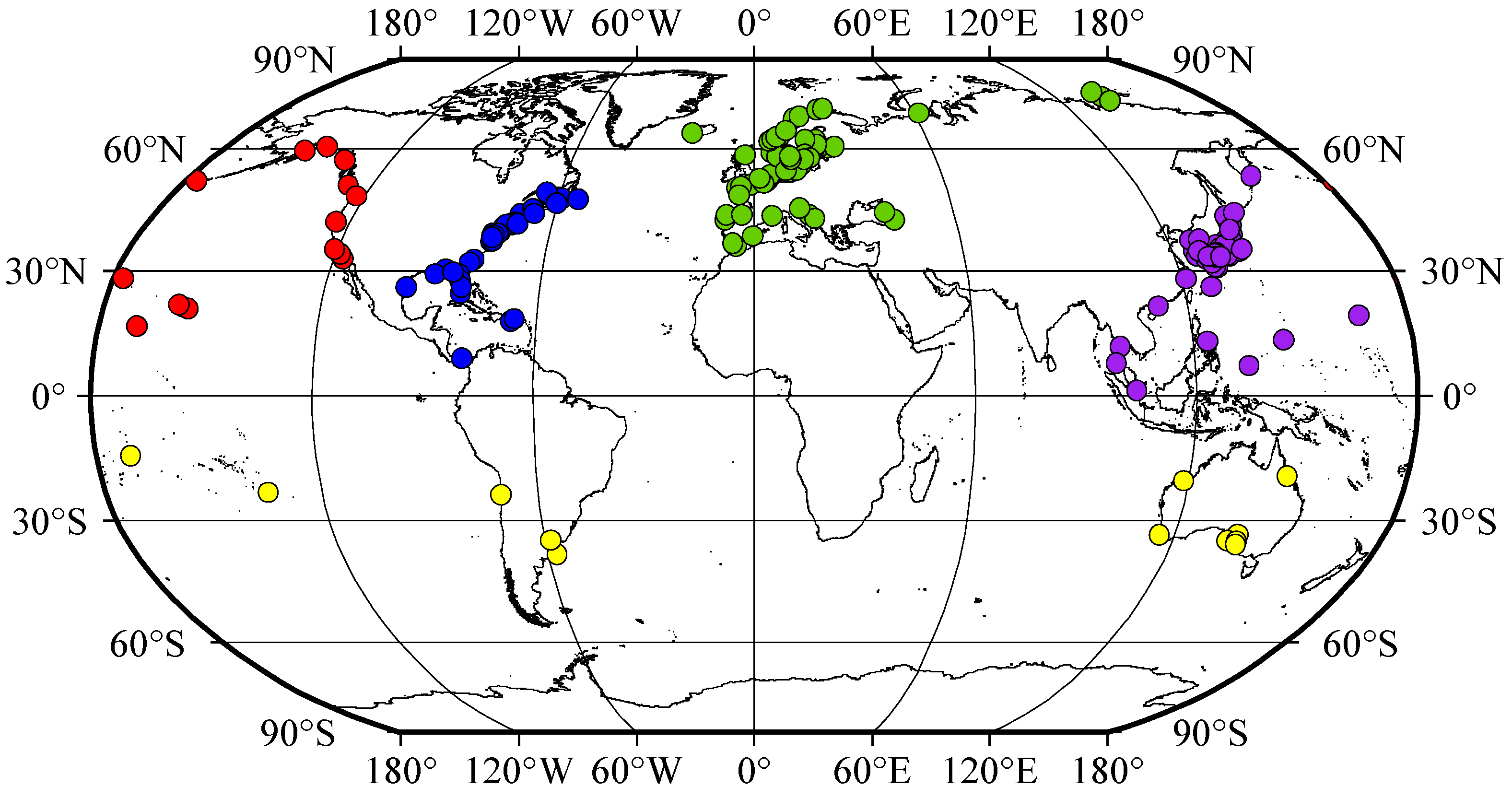

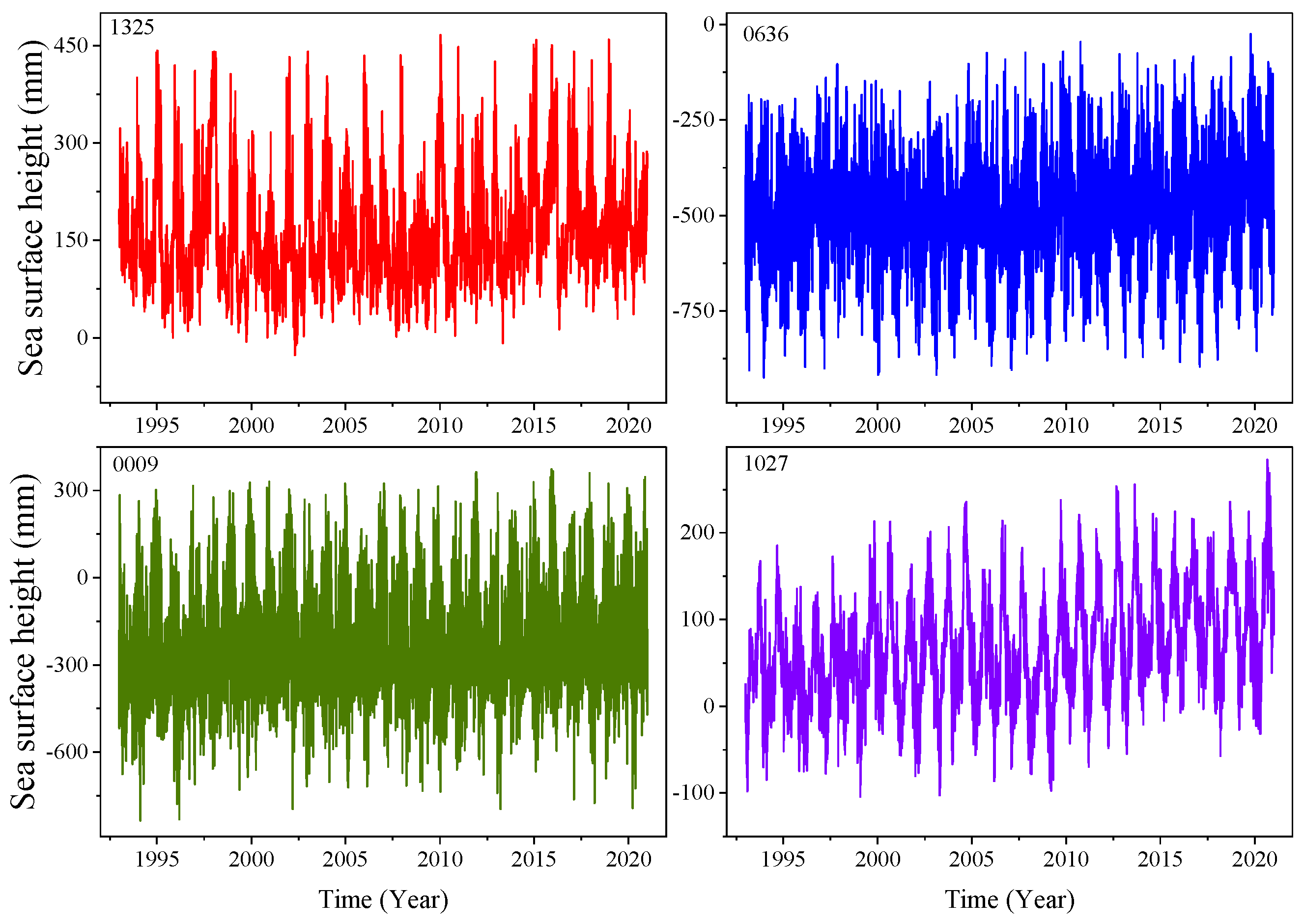
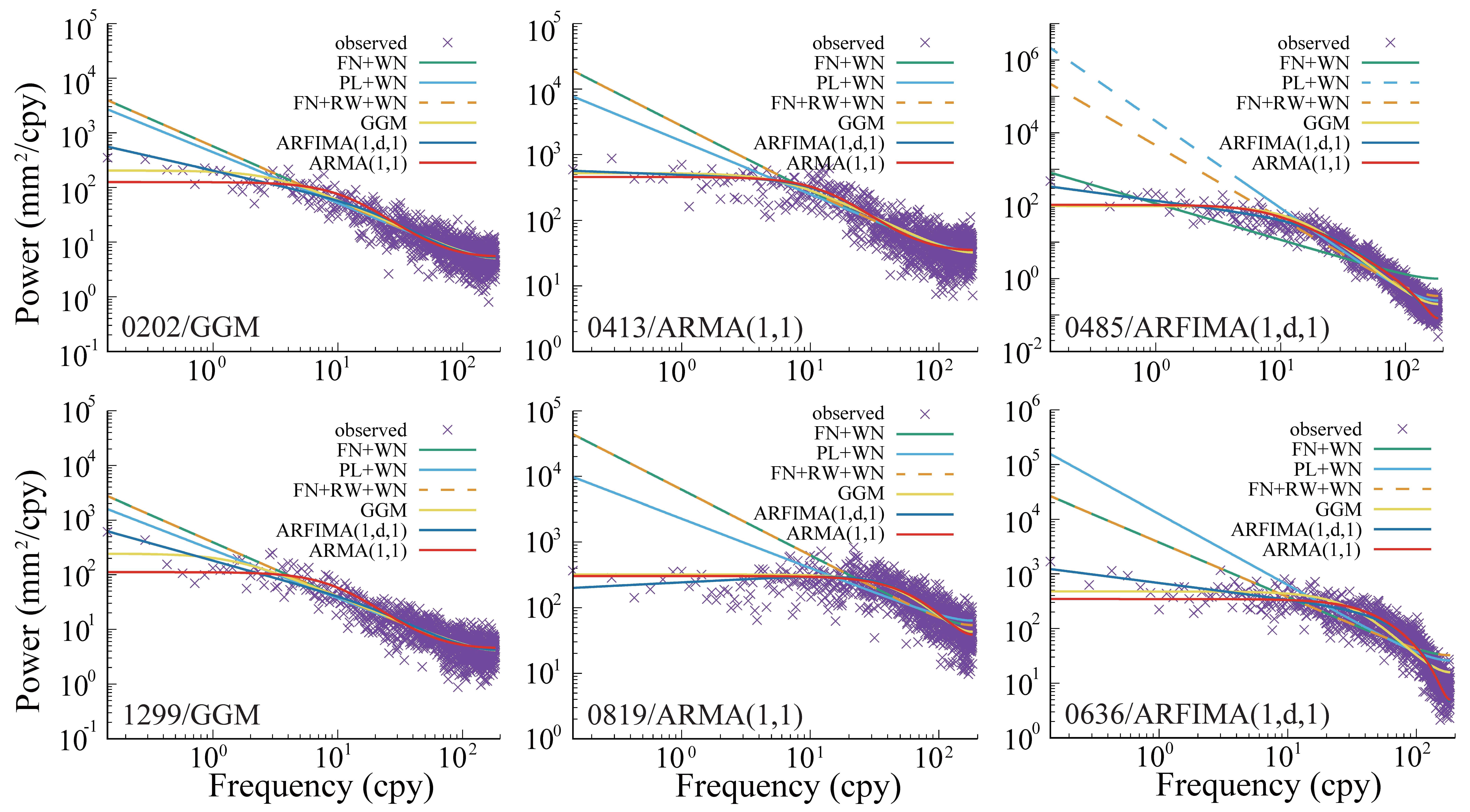



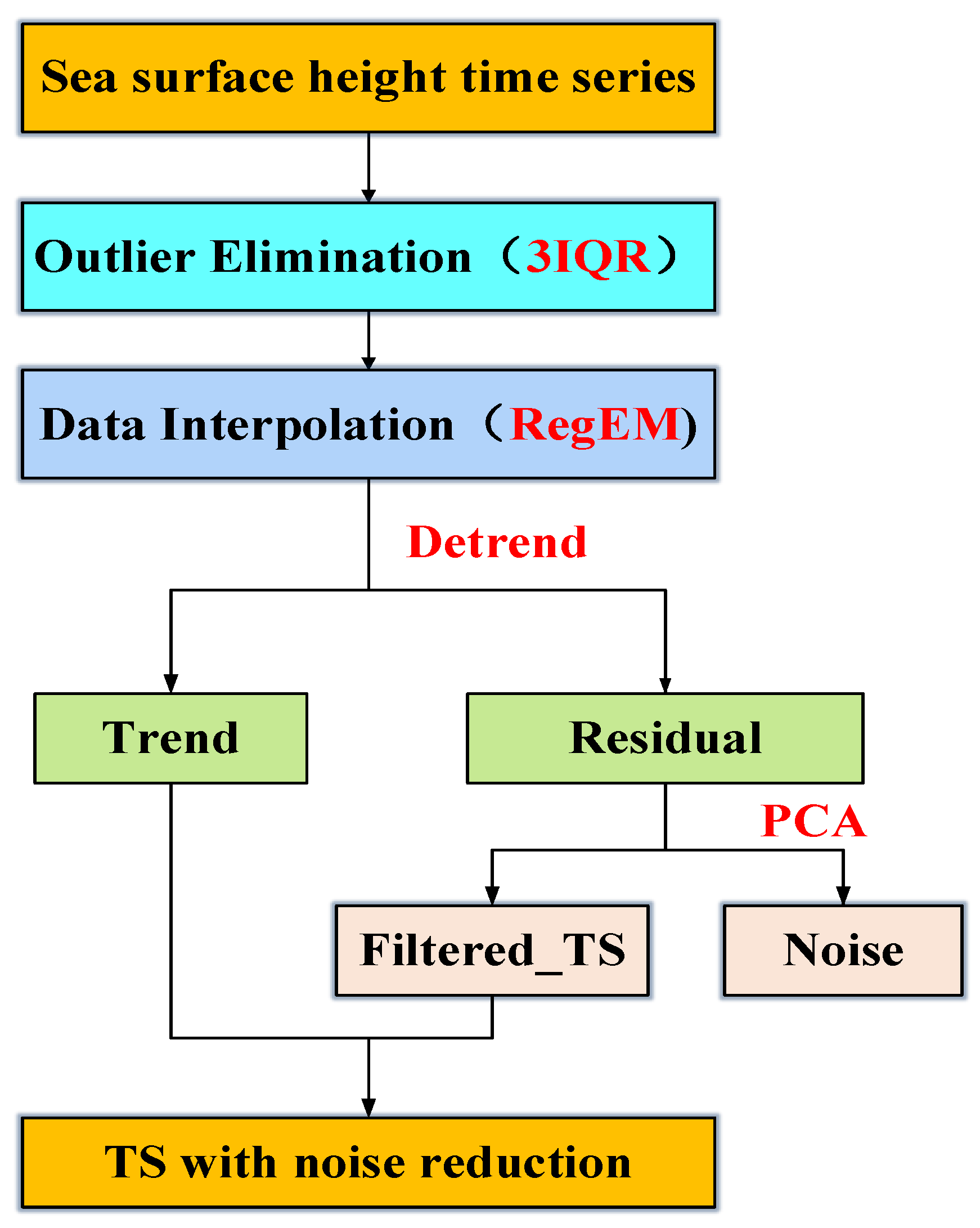

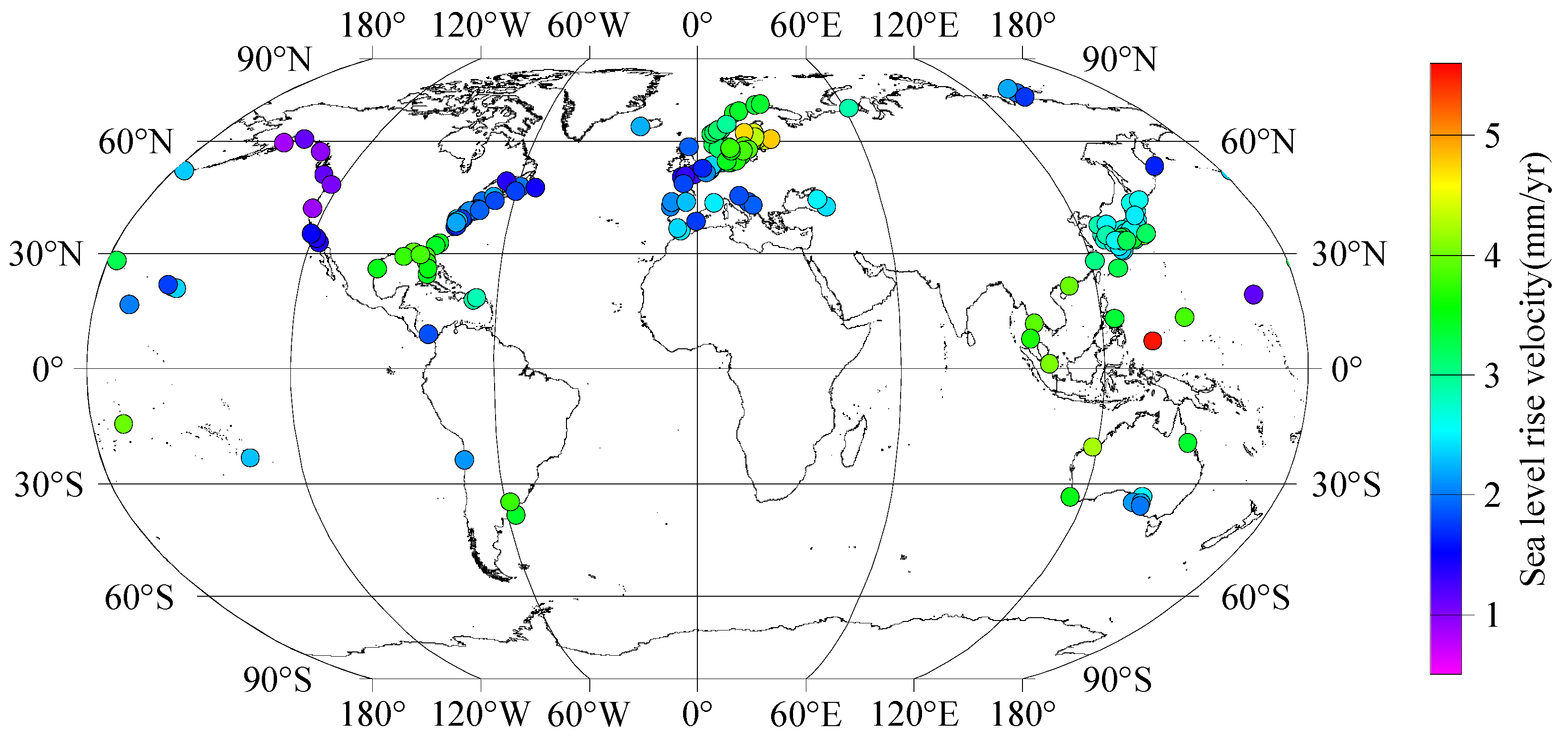
| Difference [mm/yr] | Proportion |
|---|---|
| <0 | 22.3% |
| 0~0.2 | 75.0% |
| >0.2 | 2.7% |
| Difference | Interval Distribution | ||
|---|---|---|---|
| Velocity |Raw − PCA| | [0.00, 0.10] | (0.10, 0.20] | >0.20 |
| 81.0% | 9.8% | 9.2% | |
| Uncertainty (PCA − Raw) | <0 | [0, 0.2] | >0.2 |
| 59.3% | 31.5% | 9.2% | |
Disclaimer/Publisher’s Note: The statements, opinions and data contained in all publications are solely those of the individual author(s) and contributor(s) and not of MDPI and/or the editor(s). MDPI and/or the editor(s) disclaim responsibility for any injury to people or property resulting from any ideas, methods, instructions or products referred to in the content. |
© 2024 by the authors. Licensee MDPI, Basel, Switzerland. This article is an open access article distributed under the terms and conditions of the Creative Commons Attribution (CC BY) license (https://creativecommons.org/licenses/by/4.0/).
Share and Cite
Huang, J.; He, X.; Montillet, J.-P.; Bos, M.S.; Hu, S. Enhancing Sea Level Rise Estimation and Uncertainty Assessment from Satellite Altimetry through Spatiotemporal Noise Modeling. Remote Sens. 2024, 16, 1334. https://doi.org/10.3390/rs16081334
Huang J, He X, Montillet J-P, Bos MS, Hu S. Enhancing Sea Level Rise Estimation and Uncertainty Assessment from Satellite Altimetry through Spatiotemporal Noise Modeling. Remote Sensing. 2024; 16(8):1334. https://doi.org/10.3390/rs16081334
Chicago/Turabian StyleHuang, Jiahui, Xiaoxing He, Jean-Philippe Montillet, Machiel Simon Bos, and Shunqiang Hu. 2024. "Enhancing Sea Level Rise Estimation and Uncertainty Assessment from Satellite Altimetry through Spatiotemporal Noise Modeling" Remote Sensing 16, no. 8: 1334. https://doi.org/10.3390/rs16081334





